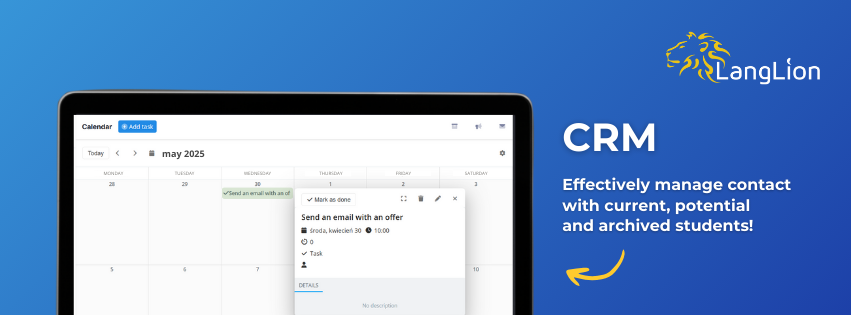
Are you wondering why, despite having a great offer and well-conducted classes, your language school isn’t attracting as many students as you’d like? Perhaps the issue isn’t with the price or marketing, but with something more everyday – how communication impacts sales in a language school.
Sometimes, it’s enough to answer the phone differently, respond better to a message, or listen more attentively to a parent for a client to stay longer. In this article, we show exactly what is worth improving and how it translates into real results.
What will you find in this article?
- Foundations of effective communication in a language school
- Building relationships as a business strategy
- How can technology support communication in a language school?
- How to measure the efficiency of communication and relationships in a language school?
- Summary – how communication impacts sales in a language school
Foundations of effective communication in a language school
When analyzing the role of relationships and communication in the sales process within a language school, it’s important to consider two aspects. This includes both relationships with clients and between employees.
The latter is often overlooked, which is a mistake! After all, one affects the other, and how external communication looks has its roots already at the level of internal relationships within the organization.
Let’s examine a simple example.
The reception desk receives an inquiry from a parent about the possibility of changing the group for their child. They pass it on to the instructor but do not receive any feedback. The instructor, busy conducting classes, responds only after several days. In the meantime, the parent receives no information, becomes anxious, and starts considering withdrawing the child from the course. By the time the issue is resolved, trust in the school has been significantly undermined, and the chance of continuing education decreases.
Conclusion: a lack of clear rules for passing information and reacting „here and now” can cost the loss of a customer – even if the classes themselves are conducted at the highest level.
Communication channels in a language school
The first step to improving communication is understanding how information currently flows in your organization.
In a typical language school, we can distinguish the following communication channels.
- Internal communication:
- Between the owner/director and the administrative staff
- Between the administration and the instructors
- Between the instructors
- Among all employees
- External communication:
- School → potential clients
- School → current students
- School → parents of students (in the case of children)
- School → business partners and service providers
Team relationships (instructors, reception, marketing, management) have a real impact on the quality of communication with the students.
Building relationships as a business strategy in your language school
Language schools that excel in sales typically focus on creating a positive atmosphere within the team and authentic relationships with students – this is their approach to long-term success.
It’s not just about standard customer service, but about a deep understanding that every interaction is an opportunity to strengthen the bond with the student.
What can you do?
- Personalize experiences – both in areas related to language learning and other aspects.
- Actively listen – try to understand the needs and expectations of students, not only regarding language learning.
- Focus on transparency and authenticity – build trust through honest communication.
Remember!
Instructors are the first line of contact with the student and have the greatest impact on their experience with the school. Often, it is the relationship with the instructor, rather than the methodology or materials themselves, that determines whether a student will recommend the school to friends or decide to continue their studies.

Student life cycle and communication touchpoints
Effective communication and strong relationships have different meanings at various stages of the student life cycle, and thus impact sales in the language school. By understanding these relationships, we can strategically plan communication activities that maximize conversion, retention, and recommendations.
Key points of communication contact are:
- Interest stage:
- Clear, valuable marketing communication
- Quick, professional response to inquiries
- Personalized proposals based on individual needs
- Onboardingstage:
- Warm welcome and introduction to the school and its culture
- Clear explanation of the learning process and expectations
- Early identification of goals and motivation
- Active learning stage:
- Regular feedback on progress
- Proactive problem solving
- Personalization of the educational experience
- Course renewal/completion stage:
- Summary of achievements and progress
- Honest discussions about future educational steps
- Follow-up with former students
Paradoxically, crisis moments – such as student dissatisfaction, complaints, or negative reviews – can become opportunities to strengthen relationships and increase customer loyalty. The key here is proactive, empathetic, and solution-oriented communication.
If you want to learn more, read the article: how do you deal with negative online reviews!
How can technology support communication in a language school?
In 2025, it is hard to imagine effective communication without the appropriate technological infrastructure. Modern tools, such as CRM in a language school not only streamlines the flow of information but also allows for the automation of routine processes, thereby freeing up valuable time for building relationships.
What key tools will help you in effective communication?
- Internal communication platform (e.g., Slack, Microsoft Teams) – enables quick information exchange among employees.
- Programs that allow you to create a task list and track work progress (e.g., Trello or Asana).
- Analytical tools (e.g., Google Analytics) – provide data necessary for making fact-based decisions.
- LangLion language school management platform – centralizes data on students, payments, attendance, and learning progress. Additionally, it features a CRM module that allows you to effectively collect and manage student data.

How to measure the efficiency of communication and relationships in a language school?
Having „good relationships” isn’t enough – it’s also worth measuring and analyzing them. Making decisions based on specific indicators is key to optimizing sales processes. Monitoring and analyzing indicators related to communication and relationships can provide you with invaluable information and highlight areas that require improvement.
What indicators can you monitor?
- Customer satisfaction index – measured regularly at various stages of the course.
- Net Promoter Score (NPS) – the willingness to recommend the school to friends.
- Retention rate – the percentage of students who continue their studies after completing a course.
- Response time to inquiries – the speed at which questions from potential and current customers are answered.
- Consultation to enrollment conversion rate – the effectiveness of the initial contact in converting interested parties into students.
- Customer lifetime value (CLV) – the total revenue generated by a single student.
Summary – how communication impacts sales in a language school
Effective communication is one of the most important elements determining the success of a language school – both in acquiring new customers and maintaining relationships with current students. From the first contact to the completion of the course, the way a school communicates with its clients and internally directly affects sales, retention, and brand image.
To improve sales results, schools should ensure consistent, empathetic, and prompt communication, based on personalization and relationships—not only between the school and students but also within the team (teachers, reception, administration).
Implementing tools such as CRM enables process automation, reduces response time, and allows for more effective management of the student’s lifecycle. Regularly measuring the effectiveness of communication (NPS, retention, response time) provides real data for optimizing sales processes.
Want to know how to effectively communicate with students, build lasting relationships, and thereby increase sales? Read our articles:
✔︎ How does plain language help in communication and marketing in a language school?
✔︎ How to measure and improve customer satisfaction in a language school?
